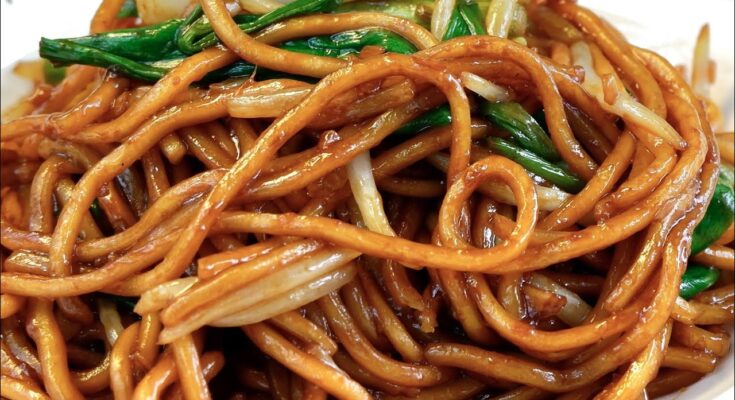Asian Noodles Recipe: If you’re craving something savory, comforting, and bursting with umami flavor, you’re in for a treat. This Asian noodles recipe is everything you love about takeout—but made at home, fresh, fast, and flavorful.
Whether you’re a kitchen pro or a beginner looking for a satisfying dish, this step-by-step guide will walk you through making the best noodles you’ve ever had.
Ready to slurp your way to deliciousness? Let’s go.
What Makes Asian Noodles So Special?
There’s something truly magical about Asian noodles. Unlike Western pasta, these noodles come in a variety of shapes, sizes, and textures—each one bringing its own personality to the dish. What makes them stand out is their versatility and how beautifully they absorb flavors. Whether it’s a quick stir-fry or a slow-simmered broth, Asian noodles always deliver comfort and satisfaction.
From the chewy bite of lo mein to the slippery softness of rice noodles, these noodles are all about contrast—soft yet structured, simple yet rich. And don’t even get me started on the sauces. With ingredients like soy sauce, oyster sauce, hoisin, and sesame oil, each slurp is packed with depth and character. It’s not just food—it’s an experience.
And the best part? You can tailor the dish to your cravings. Want spicy? Add chili oil. Feeling healthy? Go heavy on the veggies. Whether you’re cooking for one or feeding a crowd, this is the kind of meal that brings people together, one bowl at a time.
Different Types of Asian Noodles
Before we jump into the cooking, let’s get familiar with the main characters of this dish—the noodles themselves.
Wheat Noodles
Wheat noodles, such as Chinese egg noodles or lo mein, are hearty and slightly chewy. They hold up beautifully in stir-fries and are often used in chow mein or noodle soups.
Rice Noodles
These translucent noodles are made from rice flour and water. They’re gluten-free and have a lighter, more slippery texture. Think Pad Thai or Vietnamese pho.
Glass Noodles
Also called cellophane or mung bean noodles, these turn clear when cooked. They’re soft, springy, and great in both stir-fries and soups.
Soba and Udon
Soba noodles are thin and made from buckwheat, with a nutty flavor. Udon noodles are thick, chewy, and ideal for soups or stir-fry dishes.
Each type adds its own twist to the dish, and the best part is—you really can’t go wrong. Pick your favorite or mix and match to see what you love most.
Essential Ingredients You’ll Need
Here’s the beauty of an Asian noodle dish—it’s flexible. But there are some staples that really bring it to life. Let’s break it down.
Noodles (Your Choice of Type)
Choose your favorite noodle type based on texture and flavor. Lo mein and rice noodles are great for beginners. Fresh noodles work best, but dried versions are perfectly fine—just follow the cooking instructions on the package.
Protein (Chicken, Beef, Tofu, Shrimp)
The choice of protein can completely change the vibe of your noodles. Chicken and beef add richness, shrimp brings a seafood twist, and tofu is a great plant-based option.
Vegetables (Bell Peppers, Carrots, Bok Choy, etc.)
This is where color and crunch come in. Bell peppers, snap peas, mushrooms, cabbage, baby corn—you name it. A good rule of thumb: use at least three kinds for variety.
Sauces (Soy Sauce, Oyster Sauce, Hoisin, etc.)
The sauce is where the magic happens. You’ll want a combo of salty, sweet, tangy, and savory. Soy sauce is a must. Oyster sauce adds depth. Hoisin brings sweetness. Feel free to throw in some chili sauce if you like heat.
Aromatics (Garlic, Ginger, Scallions)
These aren’t optional—they’re essential. Garlic and ginger lay down the flavor base, and scallions add a fresh bite that cuts through the richness.
Oil (Sesame Oil, Vegetable Oil)
Use vegetable oil for cooking and sesame oil for flavor. A little drizzle of sesame oil at the end makes everything taste authentically Asian.
List of Ingredients (Full Detailed Table)
| Ingredient | Quantity | Notes |
|---|---|---|
| Noodles | 200g (7 oz) | Lo mein, rice noodles, or soba |
| Chicken breast | 150g (5 oz) | Thinly sliced |
| Bell peppers | 1 cup, sliced | Use red, yellow, or green |
| Carrots | 1/2 cup, julienned | Optional but adds crunch |
| Garlic | 2 cloves, minced | Fresh only |
| Ginger | 1 tbsp, minced | Grated works best |
| Soy sauce | 3 tbsp | Use low-sodium if preferred |
| Oyster sauce | 2 tbsp | Adds deep umami flavor |
| Hoisin sauce | 1 tbsp | Optional for sweetness |
| Sesame oil | 1 tbsp | Add at the end |
| Scallions | 2 stalks, chopped | For garnish |
| Vegetable oil | 2 tbsp | For stir-frying |
| Optional protein | Tofu/Shrimp/Beef 150g | Based on your preference |
| Chili sauce | 1 tsp | Optional for spice |
Tools You’ll Need in the Kitchen
- Wok or large non-stick skillet
- Cutting board and sharp knife
- Saucepan (for boiling noodles)
- Tongs or spatula
- Mixing bowls
- Measuring spoons
- Grater (for ginger)
Trust me—having the right tools makes the process quicker and a lot more fun.
Prep Work: Get Everything Ready Before Cooking
Here’s a tip from every professional chef: prep before you cook. Stir-frying happens fast, and there’s no time to chop or measure once the heat is on.
- Slice your vegetables thin so they cook quickly.
- Cut your protein into bite-sized pieces.
- Measure your sauces into a small bowl so they’re ready to pour.
- Cook your noodles slightly under— they’ll finish in the pan.
Having everything laid out makes the actual cooking process seamless. Think of it like assembling a puzzle: all the pieces should be ready to go.
Step-by-Step Guide to Making Asian Noodles
Let’s get into the real action—cooking! Here’s the exact order to follow for perfect noodles every single time.
Step 1: Cook the Noodles
Start by boiling your choice of noodles—lo mein, rice noodles, or egg noodles—in salted water according to package instructions. Drain them once al dente and toss lightly with sesame oil to prevent sticking. Set aside.
Step 2: Prepare the Sauce
In a small bowl, whisk together soy sauce, oyster sauce, sesame oil, rice vinegar, brown sugar, and a pinch of chili flakes. This savory-sweet blend gives the dish its signature umami punch.
Step 3: Sauté the Aromatics
Heat a wok or large skillet over medium-high heat. Add a splash of oil, then sauté minced garlic, ginger, and sliced onions until fragrant—this builds the flavor base.
Step 4: Cook the Protein
Add your choice of chicken, beef, shrimp, or tofu. Stir-fry until cooked through and lightly browned.
Step 5: Add the Vegetables
Toss in sliced bell peppers, carrots, cabbage, or broccoli. Stir-fry for 2–3 minutes until crisp-tender.
Step 6: Combine Everything
Add the cooked noodles and pour in the sauce. Toss everything together until the noodles are evenly coated and glossy.
Step 7: Garnish and Serve
Top with chopped scallions, sesame seeds, and a drizzle of lime juice. Serve hot and enjoy your flavorful, homemade Asian noodles!
Tips for Perfect Asian Noodles Every Time
Want to take your noodle game to the next level? Here are some solid tips to keep in mind:
- Undercook your noodles slightly. They’ll finish cooking in the stir-fry.
- Use high heat. Stir-frying is all about quick, intense heat that seals in flavor.
- Don’t overdo the sauce. It’s tempting, but too much can make your noodles soggy.
- Toss continuously. Keep everything moving to prevent sticking and burning.
- Fresh is best. Use fresh ginger and garlic over powdered versions.
And here’s a pro tip: If you’re cooking for more than 2–3 people, stir-fry in batches. Crowding the pan leads to steamed, mushy ingredients—and nobody wants that.
Common Mistakes to Avoid
Even seasoned cooks make these errors. Here’s what to steer clear of:
- Overcooking the noodles: They’ll turn mushy fast.
- Not prepping ahead: Stir-frying happens quickly. If you’re chopping while cooking, you’ll miss the magic.
- Using too many ingredients: Keep it simple. Too many veggies or proteins can muddle the flavors.
- Using a small pan: Crowding kills the stir-fry. Use a large wok or skillet.
- Skipping the aromatics: Garlic, ginger, scallions—don’t leave them out. They make the dish.
Avoid these and you’re on the path to stir-fry mastery.
Variations You Can Try
Don’t be afraid to play with the recipe. Here are a few spins to keep it interesting:
Spicy Version
- Add sriracha, chili garlic sauce, or Korean gochujang to the sauce mix.
- Toss in fresh red chilies or chili flakes during the stir-fry.
Vegan/Vegetarian
- Use tofu or tempeh as your protein.
- Replace oyster sauce with vegetarian mushroom sauce.
- Go heavy on greens like spinach, kale, or bok choy.
Low-Sodium Option
- Use low-sodium soy sauce.
- Skip oyster sauce and use a splash of rice vinegar for flavor.
- Load up on herbs like cilantro, basil, or mint to enhance taste naturally.
The beauty of this recipe is how adaptable it is. Got leftover roast chicken? Throw it in. Want to add peanuts? Go for it.
Best Side Dishes to Pair with Asian Noodles
Turn your noodle night into a full meal with these easy sides:
- Spring Rolls – Light and crispy, perfect with a sweet chili dip.
- Miso Soup – A warm, savory bowl to balance out your noodles.
- Asian Cucumber Salad – Tangy, crunchy, and refreshing.
- Kimchi – Fermented and spicy, it adds a punch of flavor.
- Steamed Dumplings – Who can say no to dumplings?
Pick one or two, and you’ve got yourself a restaurant-quality meal.
Storage and Reheating Tips
Got leftovers? Lucky you.
- Storage: Place in an airtight container and store in the fridge for up to 3 days.
- Reheating: Use a pan over medium heat with a splash of water or broth to rehydrate the noodles.
- Freezing: Not recommended, as the noodles may become mushy when thawed.
Pro tip: Add a fresh sprinkle of scallions or a drizzle of sesame oil before serving to revive the flavors.
FAQs about Asian Noodles Recipe
1. What are the healthiest Asian noodles?
Soba noodles made from buckwheat are among the healthiest. They’re high in protein, fiber, and naturally gluten-free. Rice noodles are also a great low-fat, gluten-free option.
2. Can I make this recipe gluten-free?
Absolutely. Use gluten-free soy sauce (tamari), skip oyster sauce (or find a GF version), and stick to rice or glass noodles. Always double-check labels.
3. How do I prevent my noodles from sticking?
After boiling, rinse them with cold water and toss them in a teaspoon of oil. Stir-fry them quickly and keep things moving in the pan.
4. Which oil is best for stir-frying noodles?
Use neutral oils with a high smoke point like vegetable, canola, or peanut oil. Finish with sesame oil for flavor—don’t cook with it as it burns easily.
5. Can I freeze cooked Asian noodles?
Technically yes, but it’s not ideal. The texture may suffer after thawing. It’s best to eat them fresh or within a couple of days from the fridge.
Conclusion
There you have it—your complete, step-by-step guide to making flavorful, restaurant-worthy Asian noodles right in your own kitchen. Whether you’re new to stir-frying or a seasoned pro, this dish is endlessly customizable and always satisfying.
From the sizzle of aromatics to the final toss in that savory sauce, every step is part of the magic. And let’s be real—once you taste homemade noodles done right, takeout just won’t cut it anymore.
So, grab your wok, pick your favorite noodle, and let the cooking begin. The slurp-worthy reward? Totally worth it.



